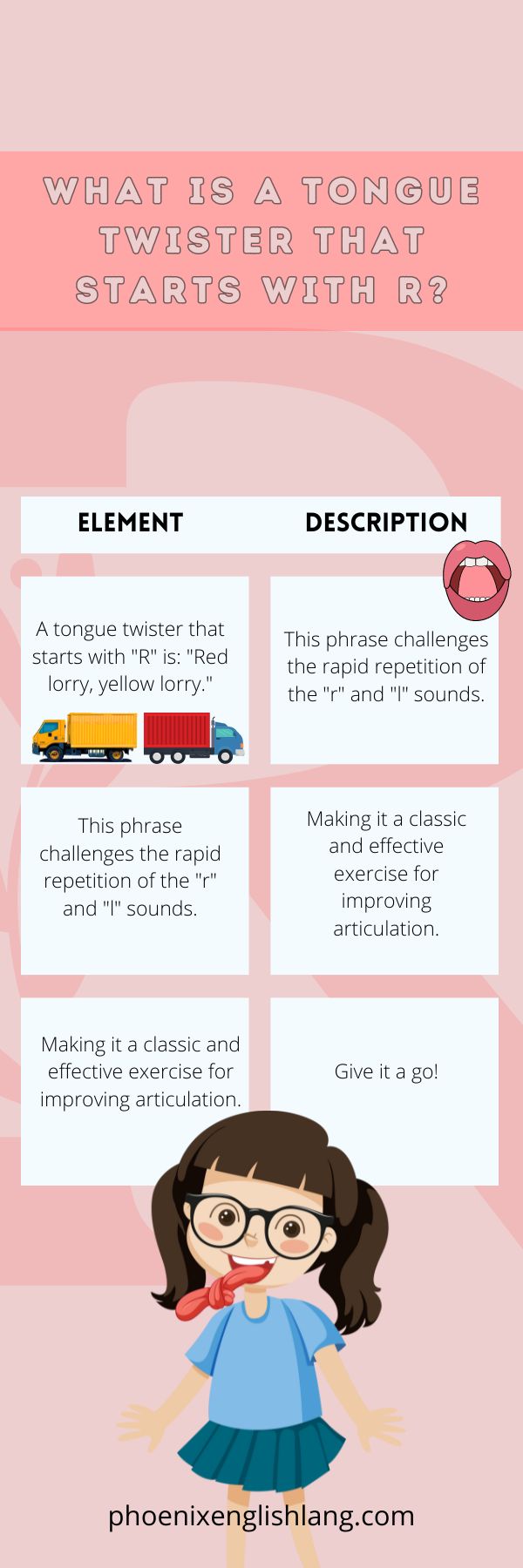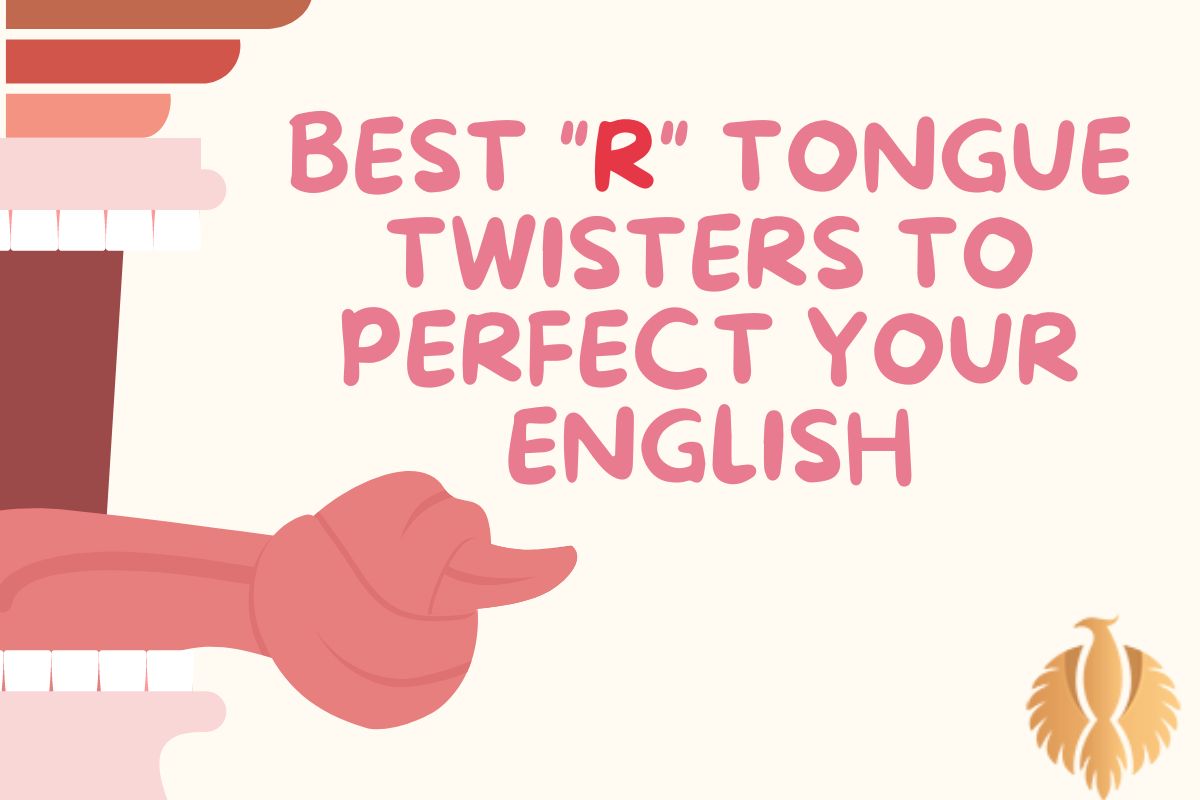To kick off our exploration, the title “Best R Tongue Twisters To Perfect Your English” suggests a fun yet effective way to enhance your pronunciation, diction, and overall command of the English language through the use of tongue twisters featuring the letter “R.”
These playful phrases are not just an entertaining challenge; they serve as excellent tools for language learners and native speakers alike, helping to improve articulation and fluency.
![a infographic for Best R Tongue Twisters To Perfect Your English [2025]](https://phoenixenglishlang.com/wp-content/uploads/2024/05/unnamed.png)
Now, let’s dive into why tongue twisters, particularly those emphasizing the “R” sound, are so valuable.
The English language is rich with unique sounds and phonetic nuances that can sometimes be tricky to master, especially for non-native speakers.
The “R” sound is notably one of the more challenging phonemes to pronounce correctly, which can lead to misunderstandings or less effective communication.
Tongue twisters provide a practical method to practice these sounds repetitively, allowing you to develop confidence in your speaking abilities.
In the realm of language learning, incorporating fun and engaging methods can significantly enhance the acquisition process. Tongue twisters offer that perfect mix of enjoyment and challenge.
When you repeatedly try to articulate phrases like “round and round the rugged rock the ragged rascal ran,” not only do you train your mouth and vocal cords to form the “R” sound correctly, but you also cultivate listening skills as you pay attention to your pronunciation.
As we progress through this article, we’ll present a compilation of the best “R” tongue twisters specifically designed to sharpen your linguistic skills.
Each tongue twister will be accompanied by tips on how to practice effectively, focusing not just on speed but also on clarity and expression.
We’ll cover various contexts in which these phrases can be used, making them relevant for both casual conversations and more formal language settings.
By embracing this playful yet purposeful approach to learning, you’ll find that tongue twisters can serve as a gateway to greater fluency in English.
Whether you’re an English learner striving to improve your pronunciation, an experienced speaker looking for a fun way to refine your skills, or even a teacher searching for innovative methods to engage students, our curated selection of “R” tongue twisters will aid you in your quest for perfecting English.
So, prepare to twist your tongue and strengthen your spoken English through this engaging practice, and let’s unlock the power of pronunciation together!
You might also enjoy: Th Tongue Twisters To Improve Your English + Pronunciation [2024]
What is a tongue twister that starts with R?

A tongue twister that starts with “R” is: “Red lorry, yellow lorry.” This phrase challenges the rapid repetition of the “r” and “l” sounds, making it a classic and effective exercise for improving articulation. Give it a go!
Rolling and Resonant Tongue Twisters

Rolling and resonant, tongue twisters that revolve around the elusive ‘R’ sound create a unique linguistic challenge, captivating speakers in a cascade of rhythmic complexity.
These verbal acrobatics serve as a fascinating exercise, both testing and enhancing one’s ability to navigate the intricacies of pronunciation.
At the heart of many ‘R’ tongue twisters lies the challenge of rolling the ‘R’ sound, a distinctive feature in numerous languages.
For instance, the classic phrase “Red lorry, yellow lorry” encapsulates the playful struggle of swiftly pronouncing ‘R’ sounds consecutively.
This not only refines articulation but also highlights the phonetic peculiarity associated with the letter ‘R.’
Engaging with ‘R’ tongue twisters can be an amusing endeavor, transforming language practice into a lively pursuit.
The repetitive nature of these phrases, such as “Rory the warrior and Roger the worrier,” encourages individuals to unravel the verbal knot with precision.
The more one delves into the rhythmic tapestry of ‘R’ twisters, the more adept they become at navigating the twists and turns of pronunciation.
The ‘R’ sound, with its varied articulations, presents a unique challenge. Whether it’s the vibrant trill of the rolled ‘R’ or the subdued resonance of the soft ‘R,’ these tongue twisters invite speakers to dance through the spectrum of ‘R’ sounds.
“Robert Rowley rolled round the round ramp,” for instance, showcases the versatility of this letter in creating a linguistic labyrinth.
Beyond the linguistic gymnastics, ‘R’ tongue twisters contribute to broader language skills. They enhance phonemic awareness, sharpening one’s ability to distinguish subtle variations in sounds.
Additionally, the mental agility required to conquer these twists fosters cognitive development, as individuals learn to coordinate rapid speech movements and navigate the auditory landscape.
Therefore,’R’ tongue twisters are not merely linguistic challenges; they are a vibrant symphony of sound, inviting speakers to master the art of rolling and resonating with finesse.
Through the playful dance of words, these twisters elevate language practice, turning it into a delightful journey through the intricate landscape of pronunciation and phonetics.
So, roll your ‘R’s with gusto and embrace the linguistic adventure that ‘R’ tongue twisters unfold.
Duality: The prefix “bi-” indicates duality or two parts, making it relevant in various contexts where comparisons or pairings are made.
Red lorry, yellow lorry: A classic tongue twister focusing on the contrast between red and yellow vehicles, helping with clarity in the “R” sound.
Round and round the rugged rock the ragged rascal ran: This phrase emphasizes the fluidity required for the “R” sound in various positions, often used in vocal exercises.
River rabbits run rapidly: Illustrates rapid speech while maintaining the “R” sound, useful for practicing speed in pronunciation.
Ricky really remembers Rocco’s red rider: Challenges the speaker to articulate multiple “R” sounds without hesitation, enhancing clarity in storytelling.
Rarely, really, the rabbit ran rapidly: Focuses on the rate of speech while incorporating the “R” sound, useful for improving enunciation in fast-paced scenarios.
Robust Robert runs rapidly: A playful phrase to help with the quick repetition of sounds and names in conversational English.
A big black bug bled blue blood: While not overly obvious, it works well in transitioning between “B” and “R” sounds, facilitating smoother speech.
Rough and ready rendezvous: Emphasizes the flow and introduction of “R” in different words, good for practice in formal or informal settings.
Racing rabbits race around the racetrack: Great for practicing speed in articulation, especially in a competitive context.
Robbers rob a red barn: This works well in storytelling scenarios, helping with clarity of character actions and emotions.
Ripe red raspberries: A useful phrase when discussing fruits, enhancing vocabulary in culinary contexts.
Rambunctious raccoons rummaging randomly: Perfect for storytelling, illustrating animal behavior while focusing on quick pronunciation of “R.”
Rapid results require rigorous reviews: Useful in an academic or business context, highlighting the importance of thorough evaluations.
Rainy days bring rainy roads: A reflection on weather, excellent for discussions about climate or planning events.
Rusty rails run across the ravine: Useful in architectural or travel discussions, helping articulate descriptions of landscapes or structures.
Resting rabbits relax in the shade: Great for softening the tone in discussions about nature or animal behavior.
Riding on the rusty rollercoaster: Perfect for amusement park discussions, again focusing on “R” clarity amidst excitement.
Robin’s red breast brought bright butterflies: Enhances descriptive language when discussing nature, suitable for education or storytelling.
Revved up engines roar on road trips: Focused on travel, this phrase is excellent for discussing adventures or vacation plans.
Rowdy racetrack rivals race recklessly: This creates excitement and drama when discussing competitive events, emphasizing the importance of pronunciation under pressure.
Roses are red, violets are blue: A classic rhyme, useful in poetry discussions or romantic settings, enhancing emotional expression.
Rough waves roll onto the rocky shore: This works well for descriptive language in environmental studies or narrative travel discussions.
Regular rhythms relax restless readers: Focuses on reading proficiency and fluency, useful in education and literacy contexts.
Rusty old roofs ringing with raindrops: Descriptive for weather discussions, enhancing vocabulary while focusing on the “R” sound.
Raccoons rummaging through rubbish: Helps articulate discussions on waste management or wildlife behavior effectively.
Rugged rocks rise restlessly: Enhances descriptive language about nature, great for storytelling or geographic discussions.
Rancid radishes ruin recipes: Useful in culinary contexts, enhancing vocabulary around food preparation and quality.
Radiant rainbows reflect after rain: Perfect for discussing weather phenomena or art, with a focus on bright imagery.
Rich red sauces splatter rapidly: Useful in cooking discussions or classes, emphasizing action in the kitchen.
Riling up a restless raccoon: Great for playful storytelling or humorous anecdotes, enhancing creative expression.
Remarkable results reveal real root causes: Useful in analytical discussions within academic or professional settings.
Rugby players run rigorously: Focuses on sports discussions, enhancing vocabulary related to athletics.
Robust research reveals real relationships: Suitable for academic contexts where thoroughness and clarity are required.
Restoration of a rare relic rocks: Useful in historical discussions, emphasizing the value of preservation.
Riding quickly on rugged roads: Great for travel narratives, emphasizing experiences and adventure.
Reluctant robins return in spring: Creates imagery in nature discussions, focusing on seasonality and wildlife behavior.
Ring the red bell before running: A reminder in safety discussions, emphasizing the importance of communication.
Rosy red cheeks in chilly weather: Useful in discussions about health and wellness, emphasizing personal experiences.
Resolute readers relish rare books: Promotes literature discussions and appreciation for unique works.
Radical recipes resurrect rustic meals: Enhances culinary discussions about the revival of traditional dishes.
Remarkable renewables reduce reliance: Useful in sustainability discussions, emphasizing the importance of green energy.
Rumbling trains rustle through rural regions: Focused on transportation and geography, enhancing discussions about community connections.
Radiant reflections right at dawn: Creates vivid imagery and can enhance creative writing or poetry.
Rebellious rats race around the room: Playful and fun, perfect for engaging storytelling or children’s literature.
Robotic arms utilize remarkable resources: Useful in tech discussions, focusing on advancements and engineering.
Reckless riders risk real repercussions: Emphasizes safety and caution in thrill-seeking activities or sports.
Robust rhymes resonate with readers: Engaging for poetry discussions or creative writing workshops.
Rigorous reviews reflect real performance: Ideal for professional environments discussing evaluations and feedback.
Racing hearts reveal real emotion: Useful in emotional discussions or storytelling, emphasizing feeling and experience.
Radiate respect for rare talents: Encourages appreciation for skills and abilities, great in mentorship or coaching discussions.
You might also enjoy: Best S Tongue Twisters To Improve Your English [2024]
The Rumbling R’s: An Exploration of Tongue Twisters
Tongue twisters are a delightful linguistic challenge that test our ability to articulate sounds quickly and accurately.
Among the various types of tongue twisters, those involving the letter “R” hold a special place.
The repetitive and rapid pronunciation of the “R” sound not only presents a linguistic hurdle but also offers a playful and entertaining experience.
In this essay, we will delve into the fascinating world of “R” tongue twisters, exploring their origins, their impact on language development, and their enduring popularity.
Origins and Evolution

Tongue twisters have a long history, with “R” tongue twisters being no exception. The precise origins of these tongue twisters are difficult to trace, as they have evolved and been passed down through generations.
However, it is believed that many “R” tongue twisters originated from various cultures and languages, showcasing the universality of the challenge they present.
Over time, these tongue twisters have been modified, adapted, and even created anew, reflecting the creativity and linguistic playfulness of different communities.
Impact on Language Development
The use of “R” tongue twisters can have a significant impact on language development, particularly in improving pronunciation and speech clarity.
The repetitive nature of these twisters helps individuals practice the challenging “R” sound, which is notorious for causing difficulties for many language learners.
By repeatedly pronouncing these tongue twisters, individuals can strengthen the muscles in their mouth and tongue, leading to improved articulation and fluency.
Moreover, the rhythmic patterns and phonetic complexities of “R” tongue twisters can enhance phonological awareness, helping individuals develop a better understanding of sound structure and word formation.
Enduring Popularity
The enduring popularity of “R” tongue twisters can be attributed to their inherent playfulness and the joy they bring to both children and adults.
These tongue twisters often elicit laughter and amusement, making them a favorite pastime in social gatherings, language classes, and even speech therapy sessions.
Their challenging nature also adds an element of competition, as individuals strive to pronounce them flawlessly and at an increasingly faster pace.
Additionally, the internet and social media have played a significant role in spreading and popularizing tongue twisters, making them accessible to a wider audience and fostering a sense of community around this linguistic phenomenon.
“R” tongue twisters have captivated people’s attention for generations, offering a unique linguistic challenge and a source of entertainment.
Their origins and evolution reflect the diversity of languages and cultures, while their impact on language development highlights their educational value.
The enduring popularity of these tongue twisters is a testament to their ability to bring joy, laughter, and linguistic growth to individuals of all ages.
So, the next time you find yourself tangled in the rumbling “R’s,” remember to embrace the challenge and enjoy the delightful journey of tongue twisters.
You might also enjoy: Top 40 English Pronunciation Guidelines You Must Know [2024]
Tongue Twisters to practice your “r” sounds

- **Robert rowed ’round the river with rapid rhythmicity.**
- **Riley’s rabbit readily ran right ’round the rosebush.**
- **Ruby’s red rubber duck rapidly rocked in the rippling river.**
- **Roger’s rambunctious rooster rigorously roared at the rising sun.**
- **Ruthie’s rare red roses radiantly reached the rustic wooden railing.**
- **Ray’s robust roar rattled the rustling leaves in the ravishing forest.**
- **Rebecca’s rustic rocking chair rhythmically rocked under the red roof.**
- **Randy the rambler rapidly raced ’round the rugged mountain range.**
- **Reginald’s rowdy parrot recited a raucous repertoire of rhymes.**
- **Rosa’s remarkable rollerblades rolled rapidly along the rocky road.**
These tongue twisters are designed to challenge your pronunciation of the “r” sound and can be a fun way to practice and improve your articulation.
Examples for r tongue twisters
Here are some tongue twisters focusing on the “r” sound:
- **Rory the rabbit rapidly raced ’round the rugged rocks.**
- **Ronnie’s red rooster rigorously roared at the rising sun.**
- **Rebecca’s rambunctious brother rambled through the radiant roses.**
- **Reggie’s rustic red wagon rumbled down the winding road.**
- **Ruby’s rare red roses radiantly rested on the rustic railing.**
- **Ricky the rambler rapidly rowed along the roaring river.**
- **Rachel’s restless cat rigorously chased the radiant rainbow.**
- **Roger’s rowdy raccoon rapidly ran through the rickety fence.**
- **Rita’s rubber duck reluctantly rolled ’round the rocky riverbank.**
- **Riley’s rickety tricycle rattled rapidly down the rustic road.**
Practice these, and you’ll be rolling your “r”s with ease!
Top 10 hardest tongue twisters
Determining the absolute “hardest” tongue twisters can be subjective, as difficulty varies from person to person. However, here are ten challenging tongue twisters known for their complexity:
| 1. **The great Greek grape growers grow great Greek grapes.** |
| 2. **A proper copper coffee pot.** |
| 3. **Six slippery snails slid silently seaward.** |
| 4. **Red lorry, yellow lorry.** |
| 5. **Irish wristwatch, Swiss wristwatch.** |
| 6. **Fuzzy Wuzzy was a bear. Fuzzy Wuzzy had no hair. Fuzzy Wuzzy wasn’t very fuzzy, was he?** |
| 7. **How can a clam cram in a clean cream can?** |
| 8. **Unique New York, you know you need unique New York.** |
| 9. **She sells seashells by the seashore. The shells she sells are surely seashells.** |
| 10. **The sixth sick sheik’s sixth sheep’s sick.** |
These tongue twisters are designed to challenge various sounds and combinations, providing a playful exercise for your vocal agility.
You might also enjoy: Percent Sign Before Or After [2024 Guide]
What are 10 tongue twisters?

Here are 10 tongue twisters for you to try:
| 1. **She sells seashells by the seashore.** |
| 2. **How can a clam cram in a clean cream can?** |
| 3. **Peter Piper picked a peck of pickled peppers.** |
| 4. **Unique New York, you know you need unique New York.** |
| 5. **Betty Botter bought some butter, but she said this butter’s bitter.** |
| 6. **Toy boat.** |
| 7. **Red lorry, yellow lorry.** |
| 8. **Sally sells sea shells beside the sea shore.** |
| 9. **Fuzzy Wuzzy was a bear. Fuzzy Wuzzy had no hair. Fuzzy Wuzzy wasn’t very fuzzy, was he?** |
| 10. **Six slippery snails slid silently seaward.** |
Have fun twisting your tongue with these!
Conclusion
In conclusion, mastering tongue twisters that focus on the “r” sound can be a rewarding and enjoyable endeavor for anyone looking to improve their English pronunciation.
The “r” sound is notoriously challenging due to its distinct pronunciation, which can vary significantly across different languages and dialects.
By practicing tongue twisters that specifically target this sound, individuals can enhance their pronunciation skills and develop better control over their speech.
One classic example of an “r” tongue twister is “Round the rugged rocks the ragged rascal ran.”
This phrase is particularly challenging because of the repetition of the “r” sound and the quick succession of syllables. It requires precise articulation and coordination of the tongue and lips to say it quickly and accurately.
Another example is “Rory’s roaring, raucous, and rowdy rabbits,” which not only focuses on the “r” sound but also incorporates alliteration, making it even more challenging to pronounce each word clearly.
Tongue twisters like these are not only fun to say but also serve as excellent exercises for improving articulation and pronunciation.
By practicing these tongue twisters regularly, individuals can train their tongue and lips to produce the “r” sound more accurately and confidently.
This practice is particularly beneficial for language learners, as many languages have different variations of the “r” sound, and mastering its pronunciation can be a significant challenge.
By focusing on “r” tongue twisters, language learners can improve their ability to produce this sound correctly and speak more fluently.
In addition to language learners, actors, public speakers, and voice artists can also benefit from practicing “r” tongue twisters.
These exercises help them warm up their vocal muscles and improve their clarity and articulation.
By incorporating “r” tongue twisters into their warm-up routine, performers can ensure that their pronunciation is precise, and their speech is clear and easily understood.
Moreover, “r” tongue twisters contribute to broader language skills by enhancing phonemic awareness. They help individuals distinguish subtle variations in sounds and improve their overall speech patterns.
The mental agility required to conquer these twists fosters cognitive development, as individuals learn to coordinate rapid speech movements and navigate the auditory landscape.
The enduring popularity of “r” tongue twisters can be attributed to their inherent playfulness and the joy they bring to both children and adults.
These tongue twisters often elicit laughter and amusement, making them a favorite pastime in social gatherings, language classes, and even speech therapy sessions.
Their challenging nature also adds an element of competition, as individuals strive to pronounce them flawlessly and at an increasingly faster pace.
Furthermore, the internet and social media have played a significant role in spreading and popularizing tongue twisters, making them accessible to a wider audience and fostering a sense of community around this linguistic phenomenon.
Engaging with “r” tongue twisters can be an amusing endeavor, transforming language practice into a lively pursuit.
The repetitive nature of these phrases encourages individuals to unravel the verbal knot with precision, making them more adept at navigating the twists and turns of pronunciation.
In summary, “r” tongue twisters are not merely linguistic challenges; they are a vibrant symphony of sound, inviting speakers to master the art of rolling and resonating with finesse.
Through the playful dance of words, these twisters elevate language practice, turning it into a delightful journey through the intricate landscape of pronunciation and phonetics.
So, roll your “r”s with gusto and embrace the linguistic adventure that “r” tongue twisters unfold.

Hi, welcome to my blog! My name is Omid and I am thrilled to have you here! I am an English language teacher with 12 years of experience and hold multiple international certifications (TESOL, IELTS, TOEFL, PTE, CELTA). Additionally, I hold a PhD in Applied Linguistics with a specialization in Teaching English as a Second Language (TESL), which fuels my passion for teaching English and assisting others in mastering the language. To me, nothing is more rewarding than helping individuals enhance their English language abilities through various methods. So, let’s embark on this journey of learning English together.




